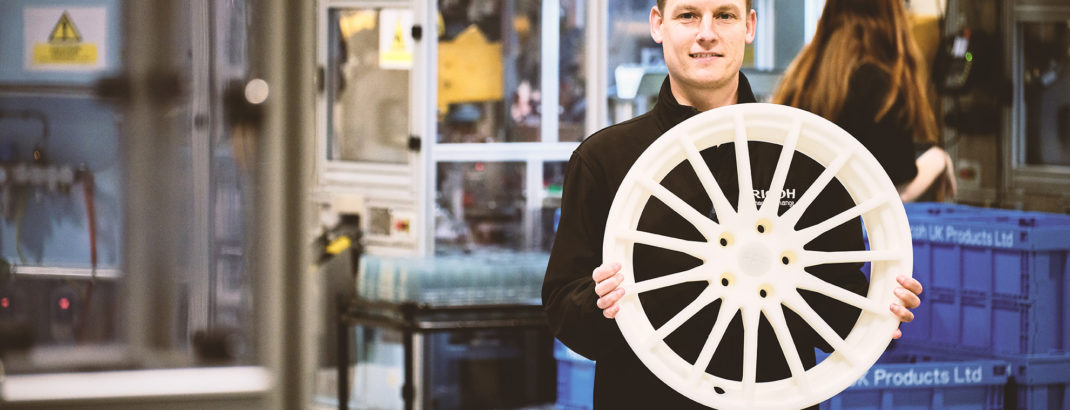Rich Minifie, Senior Additive Manufacturing Engineer at Ricoh 3D, debunks some of the myths that still surround additive manufacturing.
3D printing has been around since the 1980s, which means in manufacturing terms it’s still the new kid on the block! When businesses aren’t familiar with emerging technologies, they can often shy away from it or misunderstand its capability. Here, Rich Minifie of Ricoh 3D, discusses some of the common myths and misconceptions he encounters – and reveals the systems and materials that are supercharging production.
Myth No 1: Additive Manufacturing is expensive
When 3D printing was first invented the price of a machine soared into six digits, but you know that things have changed when you can pick up a little FDM system as part of your weekly grocery shop. Of course, I run a mile when I see these entry level devices!
The reality is the manufacturing method should depend on the job at hand. Yes, if you are mass producing a simple part then additive manufacturing is unlikely to be the most cost-effective method. Injection moulding still trumps AM for that – and most probably always will.
Where AM shines is for customised products, parts with specific or complex geometries that simply can’t be achieved with traditional methods, small runs and prototyping.
3D printing might be more expensive to create a high volume of parts, but the other benefits – no tooling costs, simplified supply chain, reduced labour and storage, and improved time to market – may outweigh that outlay, often considerably.
There is no need to invest in expensive 3D printing technology straight away, simply tap into the expertise of an end-to-end service bureau like Ricoh 3D for flexibility, access to a range of systems and materials for differing applications and to understand what’s right for your manufacturing needs.
Myth No 2: 3D printing can only create small parts
One of the misguided myths is that only small parts can be created with AM.
Using the right equipment, this simply isn’t true. At Ricoh 3D, we have large bed systems which can print up to 500mm x 500mm x 500mm, dependent on the material and part design. For even larger parts, such as car bumpers, we also use in-house joining and tooling methods to combine parts for our customers.
Myth No 3: 3D printing materials are limited
Another of the most common myths is that 3D printing materials are limited. We pride ourselves on our diverse range of materials to suit a wide range of applications – from our flexible and durable Polypropylene, to incredibly stiff and temperature resistant materials like PA6, which is resistant to fluids like fuel and oil.
The HP Multi-Jet Fusion system is our all-rounder, with PA12 offering a good balance of mechanical properties.
Thermoset is the latest innovation in our material portfolio, providing high dimensional and chemical stability, combined with exceptional flame retardancy and insulation.
If these don’t meet your needs, Ricoh 3D is set up to investigate and test an endless number of materials for any and every application.
Myth No 4: 3D printing is for prototyping, not production
This is probably the single biggest misconception that holds manufacturers back from leveraging the transformative power of 3D printing prototyping services.
3D printing production capabilities are growing all the time and, with the material and hardware developments in recent years, end-use functionality is now very much a reality.
Market research firm Gartner anticipates the medical sector will be the first to be transformed by AM, as the marketplace increasingly demands mass customisation in applications such as hearing aids and prosthetics. It’s not the only industry where disruption is occurring though. 3D printed parts are already being deployed on civilian aircraft and supercars like the BMW i8 Roadster.
Ricoh 3D is increasingly involved in a number of end-use part production projects, from coffee machine parts, to medical orthotics and even bed pans!
Myth No 5: 3D printing produces only low quality parts
The range of high-end additive manufacturing production systems on offer at Ricoh 3D are actually more likely to improve on the quality of conventional products – with super-strength internal structures, extraordinary geometries and lightweight builds all possible. By adjusting aspects like interior density, orientation and material, 3D-printed parts can be as strong or as flexible as required, with surface finish improving all the time. The most important thing is to talk to a 3D printed expert to get the design right in the first place and then to choose the right process and material for the job.

